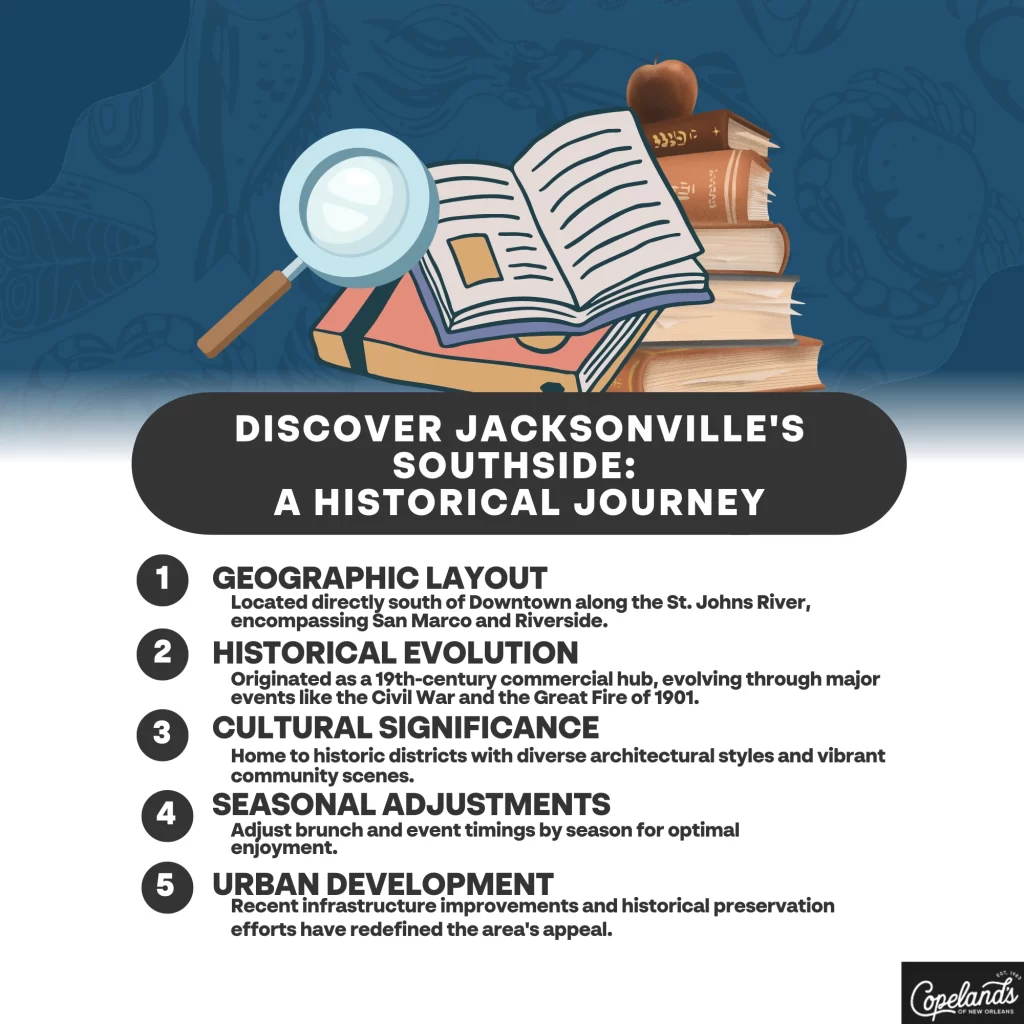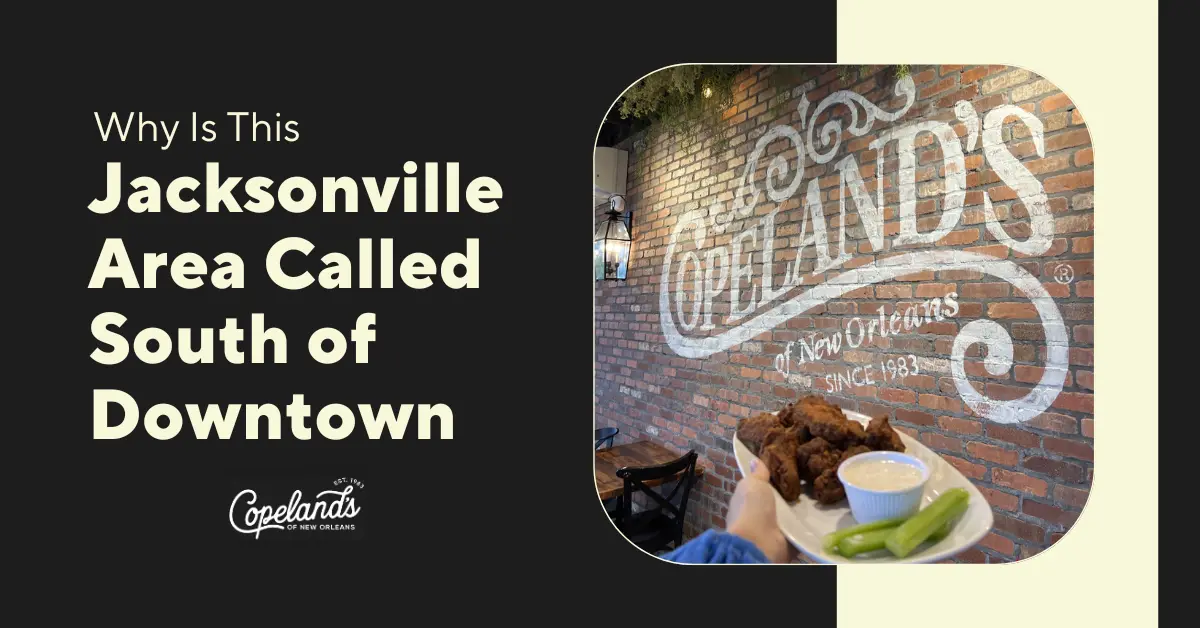You’ll discover the Jacksonville area called South of Downtown gained its name due to its location directly south of the city’s central business district along the St. Johns River. The area has a long history stretching back to the 19th century when it thrived as a commercial hub. It includes distinct neighborhoods like San Marco and Riverside, which developed unique characteristics over time. The rise of infrastructure improvements and historical preservation have further defined its identity. Exploring the detailed evolution of these neighborhoods and their modern transformation will reveal even more intriguing aspects of this dynamic region.

Key Takeaways
- The area is geographically located directly south of Jacksonville’s downtown core.
- It spans from the southern banks of the St. Johns River to neighborhoods like San Marco and St. Nicholas.
- The name helps distinguish it from the central business district and other surrounding areas.
- It’s a historical and cultural extension of Jacksonville’s downtown, with significant landmarks and neighborhoods.
- Improved transportation links and infrastructure connect it seamlessly to downtown Jacksonville.
Historical Background
In tracing the historical background of South of Downtown Jacksonville, you’ll find that its origins date back to the early 19th century when the area began to develop as a significant commercial hub. This period marked the beginning of Jacksonville’s transformation from a small settlement into a bustling center of trade and commerce. As you explore the history, it’s vital to understand how South of Downtown evolved alongside other Jacksonville neighborhoods.
In the 1820s, the establishment of the Jacksonville Landing and the construction of railroads catalyzed growth in the surrounding parts of Jacksonville. South of Downtown saw a surge in activity with the influx of merchants and settlers, drawn by the promise of economic opportunities. By the mid-19th century, this area had become one of the prominent neighborhoods in Jacksonville, FL, known for its thriving businesses and vibrant community life.
As the years progressed, the neighborhood continued to flourish, adapting to the changes brought by the Civil War, the Great Fire of 1901, and various economic shifts. Each event left its mark, shaping the character and identity of South of Downtown, making it a vital part of Jacksonville’s historical and cultural tapestry.
Geographic Boundaries
When considering the geographic boundaries south of Downtown Jacksonville, you’ll first want to pinpoint the northern boundary locations, which historically align with the St. Johns River‘s southern banks. As you trace further south, the boundary definition becomes clearer with landmarks like San Marco Boulevard and Hendricks Avenue. To complete the picture, an understanding of the east-west limits, stretching from Interstate 95 to Kings Avenue, is essential for appreciating the area’s full scope.
Northern Boundary Locations
Just south of the St. Johns River, the northern boundary of this area is demarcated by the bustling streets of LaVilla and the historic Springfield neighborhood. If you look at a Jacksonville neighborhoods map, you’ll see how these parts of Jacksonville serve as a vibrant gateway. LaVilla, once known as the “Harlem of the South,” offers a rich tapestry of African-American history and culture. This area’s lively arts scene and historic landmarks, like the Ritz Theatre, set a dynamic backdrop as you shift into the southern neighborhoods.
Springfield, on the other hand, adds a layer of architectural charm with its well-preserved Victorian homes and tree-lined streets. As one of the oldest neighborhoods in Jacksonville, FL, Springfield’s history dates back to the late 19th century. Walking through its streets, you can’t help but feel a sense of nostalgia mixed with modern vibrancy, thanks to ongoing revitalization efforts.
Both LaVilla and Springfield mark the northern edge of the area south of downtown, creating a clear geographic boundary. Their unique qualities provide a historical and cultural context that enriches the narrative of what lies further south, setting the stage for understanding this distinct part of Jacksonville.
Southern Border Definition
As you venture further south, the boundaries of this area are clearly defined by the confluence of I-95 and the San Marco neighborhood, which serve as a natural demarcation line. This southern boundary is vital in understanding the region’s geographic and cultural context within the broader landscape of Jacksonville neighborhoods. The I-95 corridor acts as a major thoroughfare, dividing different parts of Jacksonville and providing a clear, navigable edge to this southern sector.
San Marco, one of the most prominent neighborhoods in Jacksonville, FL, adds another layer of distinction. Historically, San Marco has been a focal area, known for its unique blend of residential and commercial spaces. Its proximity to downtown Jacksonville makes it a key point of reference when delineating the southern boundary.
In chronological terms, the establishment of I-95 in the mid-20th century greatly impacted how neighborhoods in Jacksonville, FL, were defined and interconnected. This freeway, combined with San Marco’s historical significance, underscores why this southern boundary is vital. As you explore various parts of Jacksonville, you’ll notice how these boundaries shape the identity and growth of the areas south of downtown.
East-West Limits Explained
To grasp the full scope of the East-West limits of the area south of downtown Jacksonville, it’s imperative to contemplate the natural and infrastructural landmarks that serve as its geographic boundaries. On the eastern side, the St. Johns River provides a natural boundary, creating a clear division as it meanders through the city. This river not only improves the area’s scenic beauty but also influences the layout of surrounding Jacksonville neighborhoods.
Moving westward, you’ll encounter significant infrastructural elements like Interstate 95, a critical artery that runs north to south through Jacksonville. This highway effectively demarcates the western limit of the South of Downtown area. As you explore a Jacksonville neighborhoods map, you’ll see how these boundaries encapsulate various neighborhoods in Jacksonville, FL, each with its unique character and charm.
Historically, this area has evolved as a mix of residential and commercial zones, with neighborhoods like San Marco and St. Nicholas adding to its vibrant tapestry. Understanding these East-West limits helps in appreciating the intricate geography and diverse communities that make up the neighborhoods in Jacksonville, FL. This context is fundamental for anyone looking to comprehend the region’s spatial dynamics fully.
Key Neighborhoods
When you explore the key neighborhoods south of Downtown Jacksonville, you’ll discover a rich tapestry of historic districts that narrate the area’s cultural evolution. Popular local spots, from charming cafes to bustling markets, provide a vibrant community atmosphere that draws both residents and visitors. Over time, these neighborhoods have developed unique residential appeal factors, making them desirable places to live with their blend of heritage and modern amenities.
Historic Districts Overview
Nestled south of downtown Jacksonville, the historic districts of San Marco, St. Nicholas, and Riverside offer a rich tapestry of architectural styles and cultural heritage that date back to the early 20th century. These neighborhoods in Jacksonville, FL, stand out as some of the most storied parts of Jacksonville, each boasting distinct histories and unique identities.
San Marco, developed in the 1920s, was inspired by Venice, Italy, and is characterized by Mediterranean Revival architecture. Its layout features grand public squares and scenic waterways, reflecting the opulence of its early residents. Moving a bit east, St. Nicholas presents a more eclectic mix of styles, including Craftsman bungalows and Tudor Revival homes. This area evolved rapidly during the 1920s and 1930s, becoming a vibrant residential enclave.
Riverside, one of the oldest neighborhoods in Jacksonville, emerged in the late 19th century. It showcases an array of Victorian, Colonial Revival, and Prairie School structures. The district’s growth mirrored Jacksonville’s expansion, with many homes built by affluent businessmen and professionals. These Jacksonville neighborhoods not only encapsulate the architectural evolution of the city but also offer a glimpse into the social dynamics that shaped parts of Jacksonville over the decades.
Popular Local Spots
Exploring the popular local spots in San Marco, St. Nicholas, and Riverside reveals a blend of historic charm, vibrant cultural scenes, and community-centric attractions that make these neighborhoods unique. Each of these parts of Jacksonville offers distinct experiences worth delving into.
- San Marco: Known for its iconic lions, San Marco is one of the most vibrant neighborhoods in Jacksonville, FL. Begin your journey at San Marco Square, where boutique shops and upscale dining options await. The historic San Marco Theatre adds a classic touch, showcasing films in an art-deco setting.
- St. Nicholas: Nestled between San Marco and the St. Johns River, St. Nicholas is a treasure trove of historic homes and lush green spaces. Stroll through its tree-lined streets to discover hidden gems like the St. Nicholas Train Station, which dates back to the early 20th century.
- Riverside: This eclectic neighborhood is renowned for its cultural diversity and artistic flair. The Riverside Arts Market, held every Saturday, is a must-visit. Here, you’ll find local crafts, farm-fresh produce, and live entertainment under the Fuller Warren Bridge.
These Jacksonville neighborhoods each contribute to the rich tapestry of the city, offering something unique for everyone to enjoy.
Residential Appeal Factors
San Marco, St. Nicholas, and Riverside each offer distinct residential appeal factors, making them some of the most sought-after neighborhoods south of downtown Jacksonville. San Marco, with its elegant Mediterranean Revival architecture, provides a blend of historic charm and modern amenities. Its central square, filled with boutiques, dining, and a historic theater, creates a vibrant community atmosphere. Residents love the walkability and proximity to the St. Johns River, enhancing the overall appeal.
St. Nicholas, on the other hand, offers a more relaxed suburban feel. Known for its tree-lined streets and family-friendly environment, it’s ideal for those seeking a quieter lifestyle. The neighborhood’s close proximity to excellent schools and convenient access to downtown make it a prime choice for families.
Riverside stands out for its unique bohemian vibe and artistic community. The neighborhood is home to the Cummer Museum of Art and Gardens and several trendy coffee shops and eateries. Its historic district showcases early 20th-century architecture, attracting those who appreciate cultural heritage.
When you examine the jacksonville neighborhoods map, these neighborhoods in Jacksonville, FL, clearly illustrate the diverse living options available south of downtown, each catering to different lifestyle preferences.
Urban Development
Urban development in the area south of downtown Jacksonville has seen a significant transformation over the past decade, driven by strategic investments and community initiatives aimed at revitalizing this historic part of the city. Once overshadowed by other parts of Jacksonville, neighborhoods in Jacksonville FL like San Marco and St. Nicholas are now flourishing.
Here’s how it’s happening:
- Infrastructure Improvements: The city has invested heavily in upgrading roads, public transportation, and utilities. This makes it easier to navigate these Jacksonville neighborhoods and boosts overall connectivity.
- Mixed-Use Developments: New constructions often blend residential, commercial, and recreational spaces. This approach has turned parts of Jacksonville into vibrant, walkable communities where you can live, work, and play without needing to travel far.
- Community Engagement: Local initiatives have fostered a strong sense of community. Neighborhood associations and local businesses collaborate to host events and activities, drawing residents closer together.
These efforts began around 2010, when the city recognized the potential of revitalizing these neighborhoods in Jacksonville FL. The transformation has been gradual but consistent, making the area south of downtown a model for urban renewal. Strategically planned and community-driven, this development aims to preserve historical integrity while accommodating modern needs.
Cultural Significance
The area south of downtown Jacksonville boasts a rich tapestry of cultural significance, rooted in its historical landmarks, diverse communities, and vibrant arts scene. You’ll find that this part of Jacksonville has been a cornerstone of the city’s heritage. Dating back to the early 20th century, neighborhoods in Jacksonville, FL like San Marco and St. Nicholas have preserved their architectural charm and historical relevance.
San Marco, one of the most distinguished Jacksonville neighborhoods, showcases Mediterranean Revival-style homes and iconic landmarks like the San Marco Theatre. As you explore further, you’ll see how the community’s Italian-inspired public squares and fountains mirror its deep-rooted history.
The parts of Jacksonville south of downtown are not just about history; they’re teeming with cultural importance. The Southbank Riverwalk, for instance, offers a picturesque setting for public art installations and live performances. Annual events like the Jacksonville Jazz Festival highlight the area’s commitment to the arts.
In these neighborhoods, the blend of historical and contemporary elements creates a unique cultural milieu, making the area south of downtown Jacksonville a significant cultural hub within the broader city landscape.
Transportation Links
Steering south of downtown Jacksonville is facilitated by a robust network of transportation links, including major highways, public transit options, and pedestrian-friendly pathways. These transportation links are essential for connecting the South of Downtown Jacksonville to the broader metropolitan area and beyond.
First established in the early 20th century, the expansion of highways like I-95 and US-1 has greatly improved accessibility to various Jacksonville neighborhoods. Public transit has also evolved, with the Jacksonville Transportation Authority (JTA) providing bus services that reach deep into South of Downtown Jacksonville. In recent years, the focus has shifted toward pedestrian and bike-friendly pathways, reflecting a broader national trend toward sustainable urban mobility.
Here are three key transportation links you should know about:
- Interstate 95 (I-95): This major highway runs north-south, offering quick access to downtown and other parts of the city.
- Jacksonville Skyway: An automated people mover system that connects key areas, including stops near South of Downtown.
- JTA Bus Routes: Extensive bus services make commuting within and outside South of Downtown Jacksonville convenient.
These transportation links not only ease daily commutes but also contribute to the neighborhood’s economic and social dynamism.
Real Estate Trends
In recent years, real estate trends south of downtown Jacksonville have shown a marked increase in both residential and commercial developments, reflecting the area’s growing attractiveness and investment potential. This shift began around 2015, when developers first identified the untapped potential in various Jacksonville neighborhoods. Initially, there was a focus on renovating older properties, making them appealing to young professionals and families.
By 2018, the momentum had shifted towards new constructions, as the demand surged. Neighborhoods in Jacksonville FL, such as San Marco and St. Nicholas, saw a notable uptick in modern apartment complexes and mixed-use buildings. According to a Jacksonville neighborhoods map, these areas have experienced substantial growth, with a blend of historic charm and contemporary amenities.
In 2020, the pandemic accelerated the trend of people moving away from crowded urban centers, further boosting real estate south of downtown. Remote work capabilities made these Jacksonville neighborhoods even more desirable. Recent data from 2022 shows a continued upward trend, with property values rising and new projects constantly breaking ground. For you, this means an ever-evolving landscape ripe with opportunities for both living and investment.
Conclusion
In exploring the vibrant tapestry that is South of Downtown Jacksonville, you’ve examined its rich history, diverse neighborhoods, and dynamic urban development. Like the heartbeat of a city, this area pulses with cultural significance and evolving real estate trends, all seamlessly connected by its robust transportation links. As you probe deeper, you’ll find that understanding this locale isn’t just about geography—it’s about experiencing the living, breathing essence of Jacksonville itself.




